gtDialog Reference
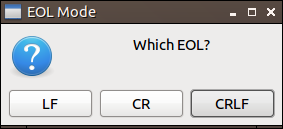
Messageboxes
gtdialog msgboxargs: A generic message box with custom button labels.gtdialog ok-msgboxargs: Identical tomsgbox, but with localized “Ok” and “Cancel” buttons.gtdialog yesno-msgboxargs: Identical tomsgbox, but with localized “Yes”, “No”, and “Cancel” buttons.
Arguments
--title str: The dialog’s title text.--string-output: Output the names of selected buttons/items or exit codes instead of button/item indexes or exit code numbers.--no-newline: Do not output the default trailing newline.--width int: Manually set the width of the dialog in pixels if possible.--height int: Manually set the height of the dialog in pixels if possible.--text str: The main message text.--informative-text str: Extra informative text.--icon str: The name of an icon to display. No icon is displayed by default. Examples are “dialog-error”, “dialog-information”, “dialog-question”, and “dialog-warning”.--icon-file str: The path to the icon to display. Has no effect when--iconis present.--button1 str: The right-most button’s label. The default is “Ok” forok-msgboxand “Yes” foryesno-msgbox.--button2 str: The middle button’s label. The default is “Cancel” forok-msgboxand “No” foryesno-msgbox.--button3 str: The left-most button’s label. The default is “Cancel” foryesno-msgbox. Requires--button2.--no-cancel: Only show “Ok” button forok-msgboxandyesno-msgbox.--float: Show the dialog on top of all windows.-
--timeout int: The number of seconds the dialog waits for a button click before timing out. Dialogs do not time out by default.
Returns
The message box dialogs return a string containing the number of the button pressed, ‘0’ if
the dialog timed out, or “-1” if the user canceled the dialog. If --string-output was given,
the return string contains the label of the button pressed, “timeout” if the dialog timed out,
or “delete” if the user canceled the dialog.
Example
gtdialog msgbox --title 'EOL Mode' --text 'Which EOL?' --icon dialog-question \
--button1 CRLF --button2 CR --button3 LF
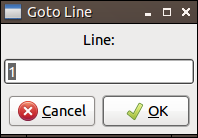
Inputboxes
gtdialog inputboxargs: A one line input box with custom button labels. An input box may have multiple entry boxes.gtdialog standard-inputboxargs: Identical to inputbox, but with localized “Ok” and “Cancel” buttons.gtdialog secure-inputboxargs: Identical to inputbox, but input is masked.gtdialog secure-standard-inputboxargs: Identical to standard-inputbox, but input is masked.
Arguments
--title str: The dialog’s title text.--string-output: Output the names of selected buttons/items or exit codes instead of button/item indexes or exit code numbers.--no-newline: Do not output the default trailing newline.--width int: Manually set the width of the dialog in pixels if possible.--height int: Manually set the height of the dialog in pixels if possible.--informative-text str [labels]: The main message text. Create multiple, labeled entry boxes by specifying one label for each box. Each label must be a separate argument. Providing a single label has no effect.--text str|list: The initial input text. Fill multiple entry boxes in order using a list of input strings. Each string must be a separate argument. Use''for blanks. Requires more than one label in--informative-text.--no-show: Mask the user input by showing typed characters as password characters.--button1 str: The right-most button’s label. The default is “Ok” forstandard-inputbox.--button2 str: The middle button’s label. The default is “Cancel” forstandard-inputbox.--button3 str: The left-most button’s label. Requires--button2.--no-cancel: Only show “Ok” button forstandard-inputbox.--float: Show the dialog on top of all windows.--timeout int: The number of seconds the dialog waits for a button click before timing out. Dialogs do not time out by default.
Returns
The input dialogs return a string containing the number of the button pressed followed by a
newline character (‘\n’) and the input text (with any multiple entries separated by newline
characters), ‘0’ if the dialog timed out, or “-1” if the user canceled the dialog. If
--string-output was given, the return string contains the label of the button pressed followed
by a newline and the input text, “timeout” if the dialog timed out, or “delete” if the user
canceled the dialog.
Example
gtdialog standard-inputbox --title 'Goto Line' --informative-text 'Line:' --text 1 --no-newline
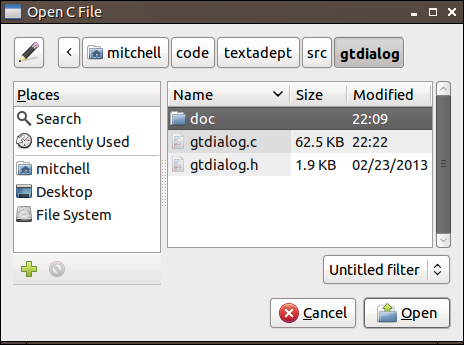
File Selection
gtdialog fileselectargs: A file selection dialog for opening files.gtdialog filesaveargs: A file selection dialog for saving a file.
Arguments
--title str: The dialog’s title text.--string-output: Output the names of selected buttons/items or exit codes instead of button/item indexes or exit code numbers.--no-newline: Do not output the default trailing newline.--width int: Manually set the width of the dialog in pixels if possible.--height int: Manually set the height of the dialog in pixels if possible.--with-directory str: The initial directory. The system determines the default directory.--with-file str: The initially selected filename. The first filename in the list is selected by default. Requires--with-directory.--with-extension list: The set of extensions to limit selectable files to. Each extension must be a separate argument with the ‘.’ being optional.--select-multiple: Enable multiple file selection infileselect.--select-only-directories: Prompt for directory selection infileselect.--no-create-directories: Prevent the user from creating new directories in filesave.
Returns
The file dialogs return a string containing the file(s) selected or the empty string if the user canceled the dialog.
Example
gtdialog fileselect --title 'Open C File' --with-directory $HOME --with-extension c h \
--select-multiple --no-newline
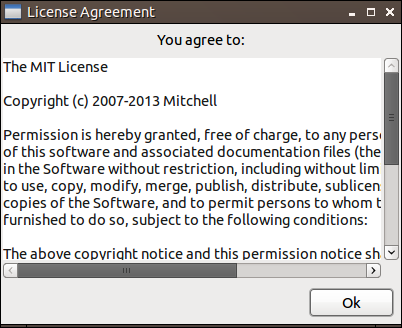
Textbox
gtdialog textboxargs: A multiple line text box with custom button labels.
Arguments
--title str: The dialog’s title text.--string-output: Output the names of selected buttons/items or exit codes instead of button/item indexes or exit code numbers.--no-newline: Do not output the default trailing newline.--width int: Manually set the width of the dialog in pixels if possible.--height int: Manually set the height of the dialog in pixels if possible.--informative-text str: Informative message text.--text str: The initial text in the textbox.--text-from-file str: The filename whose contents are loaded into the textbox. Has no effect when--textis present.--button1 str: The right-most button’s label.--button2 str: The middle button’s label.--button3 str: The left-most button’s label. Requires--button2.--editable: Allow textbox editing.--focus-textbox: Focus on the textbox instead of the dialog buttons.--scroll-to bottom|top: Scroll to the “bottom” or “top” of the textbox when not all text is visible. The default is “top”.--selected: Select all textbox text.--monospaced-font: Use a monospaced font instead of a proportional one.--float: Show the dialog on top of all windows.--timeout int: The number of seconds the dialog waits for a button click before timing out. Dialogs do not time out by default.
Returns
The textbox dialog returns a string containing the number of the button pressed and, if
--editable was given, a newline character (‘\n’) followed by the textbox text; otherwise
‘0’ if the dialog timed out or “-1” if the user canceled the dialog. If --string-output
was given, the return string contains the label of the button pressed and, if --editable was
given, a newline followed by the textbox text; otherwise “timeout” if the dialog timed out or
“delete” if the user canceled the dialog.
Example
gtdialog textbox --title 'License Agreement' --informative-text 'You agree to:' \
--text-from-file LICENSE --button1 Ok
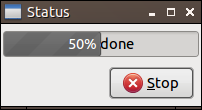
Progressbar
gtdialog progressbarargs: A progressbar dialog with updates from stdin (GTK only) or a callback function (C library only).
Arguments
--title str: The dialog’s title text.--string-output: Output the names of selected buttons/items or exit codes instead of button/item indexes or exit code numbers.--no-newline: Do not output the default trailing newline.--width int: Manually set the width of the dialog in pixels if possible.--height int: Manually set the height of the dialog in pixels if possible.--percent int: The initial progressbar percentage between 0 and 100.--text str: The initial progressbar display text. (GTK only.)--indeterminate: Show the progressbar as “busy” with no percentage updates.--stoppable: Show the Stop button.--float: Show the dialog on top of all windows.
Returns
The progressbar dialog reads lines from standard input (stdin) or a callback function and
updates the progressbar until the dialog receives an EOF or NULL. Input lines are of the
form “num str\n” where “num” is a progress percentage between 0 and 100 and “str” is optional
progress display text (GTK only). The newline character (‘\n’) is required. If “str” is
empty, the current progress display text is retained. If --stoppable is given and “str” is
either “stop disable” or “stop enable”, the Stop button is disabled or enabled, respectively.
The dialog returns the string “stopped” only if --stoppable was given and the Stop button
was pressed. Otherwise it returns nothing.
Example
for i in 25 50 75 100; do echo $i $i% done; sleep 1; done | \
gtdialog progressbar --title 'Status' --width 200 --stoppable
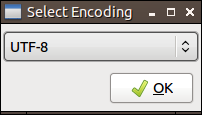
Dropdowns
gtdialog dropdownargs: A drop down list of items to select from with custom button labels.gtdialog standard-dropdownargs: Identical to drop down, but with localized “Ok” and “Cancel” buttons.
Arguments
--title str: The dialog’s title text.--string-output: Output the names of selected buttons/items or exit codes instead of button/item indexes or exit code numbers.--no-newline: Do not output the default trailing newline.--width int: Manually set the width of the dialog in pixels if possible.--height int: Manually set the height of the dialog in pixels if possible.--text str: The main message text.--items list: The list of items to show in the drop down. Each item must be a separate argument.--button1 str: The right-most button’s label.--button2 str: The middle button’s label.--button3 str: The left-most button’s label. Requires--button2.--no-cancel: Only show “Ok” button forstandard-dropdown.--exit-onchange: Selecting a new item closes the dialog.--select int: The zero-based index of the item in the list to select. The first item in the list is selected by default.--float: Show the dialog on top of all windows.--timeout int: The number of seconds the dialog waits for a button click before timing out. Dialogs do not time out by default.
Returns
The dropdown dialogs return a string containing the number of the button pressed (or ‘4’ if
--exit-onchange was responsible) followed by a newline character (‘\n’) and the index of
the selected item starting from 0, ‘0’ if the dialog timed out, or “-1” if the user canceled
the dialog. If --string-output was given, the return string contains the label of the button
pressed (or ‘4’, yes ‘4’, if --exit-onchange was responsible) followed by a newline and
the selected item, “timeout” if the dialog timed out, or “delete” if the user canceled the dialog.
Example
gtdialog dropdown --title 'Select Encoding' --width 200
--items UTF-8 ASCII ISO-8859-1 MacRoman --no-cancel --string-output --no-newline
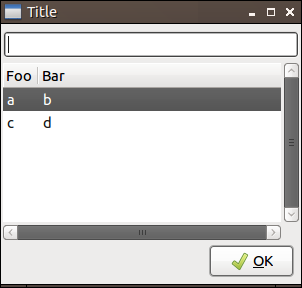
Filtered List
gtdialog filteredlistargs: A list of items to filter through and select from with custom button labels. Spaces in the filter text are treated as wildcards.
Arguments
--title str: The dialog’s title text.--string-output: Output the names of selected buttons/items or exit codes instead of button/item indexes or exit code numbers.--no-newline: Do not output the default trailing newline.--width int: Manually set the width of the dialog in pixels if possible.--height int: Manually set the height of the dialog in pixels if possible.--informative-text str: The main message text.--text str: The initial input text.--columns list: The column names for a list row. Each name must be a separate argument.--items list: The items to show in the list. Each item must be a separate argument and is inserted into the first empty column in the current list row. Requires--columns.--button1 str: The right-most button’s label.--button2 str: The middle button’s label.--button3 str: The left-most button’s label. Requires--button2.--select-multiple: Enable multiple item selection.--search-column int: The column number to filter the input text against. The default is 0. Requires--columns.--output-column int: The column number to use for--string-output. The default is 0.--float: Show the dialog on top of all windows.--timeout int: The number of seconds the dialog waits for a button click before timing out. Dialogs do not time out by default.
Returns
The filteredlist dialog returns a string containing the number of the button pressed followed
by a newline character (‘\n’) and the index of the selected item(s) starting from 0,
‘0’ if the dialog timed out, or “-1” if the user canceled the dialog. If --string-output
was given, the return string contains the label of the button pressed followed by a newline
and the selected item(s) (based on --output-column, if applicable), “timeout” if the dialog
timed out, or “delete” if the user canceled the dialog.
Example
gtdialog filteredlist --title Title --columns Foo Bar --items a b c d --no-newline
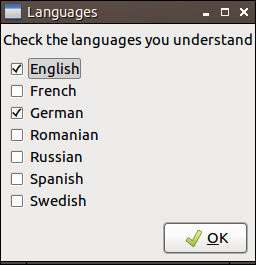
Option Selection
gtdialog optionselectargs: A group of options to select from.
Arguments
--title str: The dialog’s title text.--string-output: Output the names of selected buttons/items or exit codes instead of button/item indexes or exit code numbers.--no-newline: Do not output the default trailing newline.--width int: Manually set the width of the dialog in pixels if possible.--height int: Manually set the height of the dialog in pixels if possible.--text str: The main message text.--items list: The options to show in the option group. Each item must be a separate argument.--select indices: The zero-based indices of the options in the option group to select. Each index must be a separate argument.--button1 str: The right-most button’s label.--button2 str: The middle button’s label.--button3 str: The left-most button’s label. Requires –button2.--float: Show the dialog on top of all windows.--timeout int: The number of seconds the dialog waits for a button click before timing out. Dialogs do not time out by default.
Returns
The optionselect dialog returns a string containing the number of the button pressed followed by
a newline character (‘\n’) and the index of the selected options starting from 0, ‘0’ if
the dialog timed out, or “-1” if the user canceled the dialog. If --string-output was given,
the return string contains the label of the button pressed followed by a newline and the selected
option(s), “timeout” if the dialog timed out, or “delete” if the user canceled the dialog.
Example
gtdialog optionselect --title Languages \
--text 'Check the languages you understand' \
--items English French German Romanian Russian Spanish Swedish \
--select 0 2 --string-output --no-newline
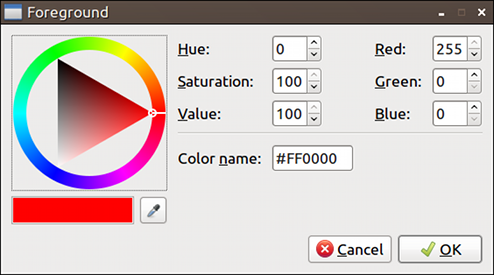
Color Selection (GTK Only)
gtdialog colorselectargs: A color selection dialog.
Arguments
--title str: The dialog’s title text.--no-newline: Do not output the default trailing newline.--width int: Manually set the width of the dialog in pixels if possible.--height int: Manually set the height of the dialog in pixels if possible.--color: The initially selected color in “#RRGGBB” format.--palette [list]: The colors to show in the dialog’s color palette. Up to 20 colors can be specified in “#RRGGBB” format. If no list is given, a default palette is shown.--float: Show the dialog on top of all windows.
Returns
The colorselect dialog returns a string containing the color selected in “#RRGGBB” format, or the empty string if the user canceled the dialog.
Example
gtdialog colorselect --title Foreground --color "#FF0000" --no-newline
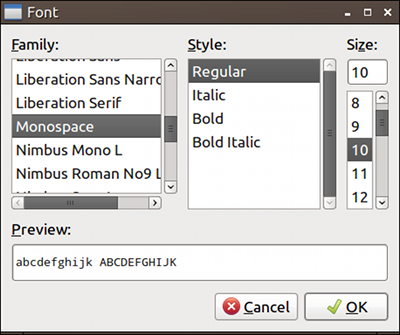
Font Selection (GTK Only)
gtdialog fontselectargs: A font selection dialog.
Arguments
--title str: The dialog’s title text.--string-output: Output the names of selected buttons/items or exit codes instead of button/item indexes or exit code numbers.--no-newline: Do not output the default trailing newline.--width int: Manually set the width of the dialog in pixels if possible.--height int: Manually set the height of the dialog in pixels if possible.--text str: The font preview text.--font-name str: The initially selected font name.--font-size int: The initially selected font size. The default size is 12.--font-style str: The initially selected font style. The available options are “regular”, “bold”, “italic”, and “bold italic”. The default style is “regular”.--float: Show the dialog on top of all windows.
Returns
The fontselect dialog returns a string containing the font selected (including style and size), or the empty string if the user canceled the dialog.
Example
gtdialog fontselect --title Font --font-name Monospace --font-size 10
Localization
For GTK only, button labels with GTK stock item labels are automatically localized. However,
when --string-output is given, the stock item label is returned, not the actual, localized
label. The default button labels are all stock item labels (“gtk-ok”, “gtk-cancel”, “gtk-yes”,
and “gtk-no”).